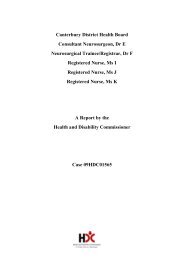Gisborne Hospital Report - Health and Disability Commissioner
Gisborne Hospital Report - Health and Disability Commissioner
Gisborne Hospital Report - Health and Disability Commissioner
Create successful ePaper yourself
Turn your PDF publications into a flip-book with our unique Google optimized e-Paper software.
<strong>Gisborne</strong> <strong>Hospital</strong> 1999 – 2000<br />
Introduction <strong>and</strong> Environment<br />
2.14 Senior nurses also felt disenfranchised, having no Director of Nursing to take<br />
their concerns direct to the Chief Executive. For example, some surgical<br />
nurses described feeling stymied in their efforts to be heard:<br />
“Nurses are at a loss about whether they should take their concerns up<br />
another step because they are then told to take the matter back to their<br />
line manager. Systems seem to be in place that are designed to stop<br />
communication <strong>and</strong> other systems that do not promote it.<br />
Communication is a key issue. The nurses do not feel part of the<br />
process. Nurses are unable to approach other disciplines without going<br />
through their line manager.”<br />
Suspicion <strong>and</strong> mistrust<br />
2.15 A sense of not being supported by management led some clinical staff to<br />
develop negative perceptions of their organisation. The investigation team<br />
heard the organisation variously described as destructive to a person’s wairua,<br />
unappreciative of nursing staff, a dysfunctional family, lacking strong<br />
leadership <strong>and</strong> bureaucratic.<br />
2.16 A senior doctor stated:<br />
“The atmosphere at the hospital is one of suspicion <strong>and</strong> mistrust.<br />
Doctors <strong>and</strong> nurses do not feel supported by the system that exists .…<br />
Clinicians [feel] fatalistic about having an impact upon the system.<br />
There is no place to solve problems. There is no sense of ownership. To<br />
get the system to work I have come up against one barrier after another.<br />
The system was a) disorganised b) void of leadership amongst medical<br />
<strong>and</strong> management staff <strong>and</strong> c) communication is absent.”<br />
2.17 Poor communication <strong>and</strong> consultation patterns were linked to the lack of trust<br />
between some senior managers <strong>and</strong> the workforce. In one doctor’s opinion<br />
this lack of trust was linked to the workforce’s unwillingness to fill out<br />
incident forms: “The problem in <strong>Gisborne</strong> is lack of trust between workforce<br />
<strong>and</strong> management …. Basically people did not have any faith in incident<br />
reporting <strong>and</strong> it was not due to the system – the system was robust enough.”<br />
2.18 The Chief Executive responded that although she accepted “there were events<br />
which did not generate an incident form <strong>and</strong> should have”, she did not believe<br />
that staff at THL in general had this approach to incident forms.<br />
2.19 Concerns were also expressed about the use of discipline at THL. It is<br />
inevitable that large organisations have a certain amount of disciplinary<br />
activity. However, a number of interviewees suggested that THL had used the<br />
disciplinary process in situations where good management practices may have<br />
prevented the breakdown in the relationship. THL responded that disciplinary<br />
action had been used sparingly <strong>and</strong> was reserved for serious situations where<br />
all other avenues of resolution had been exhausted.<br />
Targets for criticism<br />
8
















